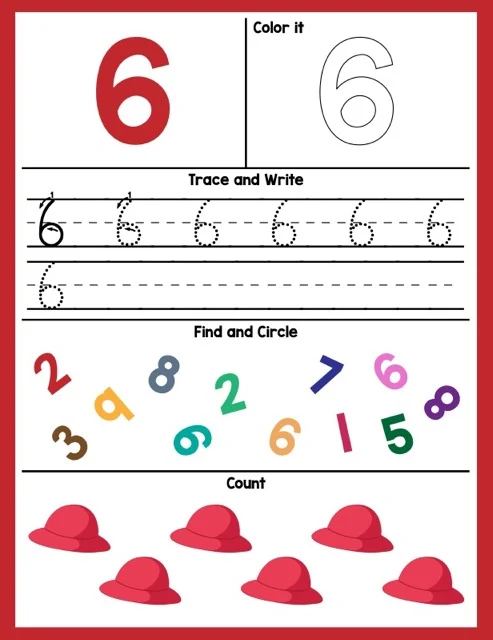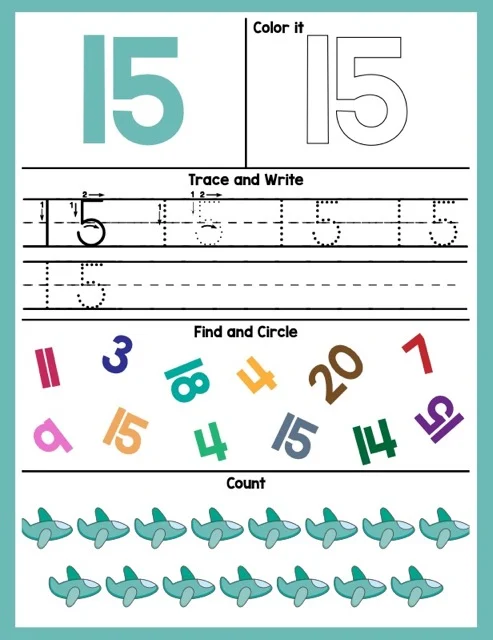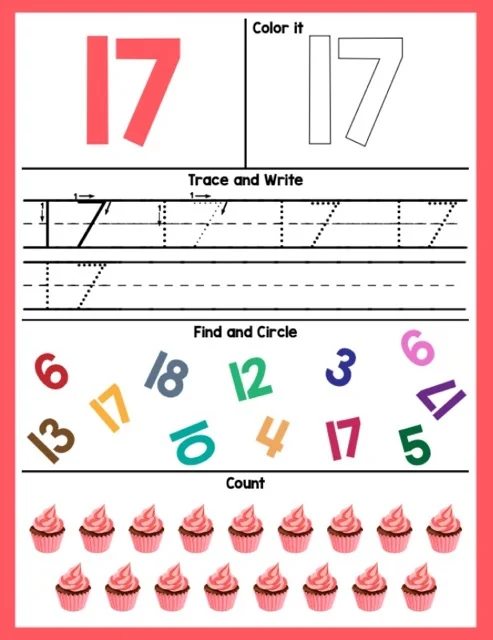Preschool Math Worksheets: Numbers 1-20
These excerpts detail number worksheets designed for preschool and kindergarten students to build early math skills. Activities include tracing, counting, coloring, and matching numbers 1-20. The worksheets are adaptable to different learning levels and can be used at home or in the classroom. Engaging strategies, such as manipulatives and gamification, are suggested to enhance learning. The worksheets aim to foster a positive learning experience by promoting multi-sensory learning and parental involvement.
Number Worksheets for Preschool & Kindergarten
Briefing Doc: Number Worksheets for Preschool and Kindergarten
Theme: Enhancing early math skills through engaging and accessible worksheets.
Key Ideas and Facts:
●
Target Audience: Preschool and Kindergarten students beginning their number recognition and counting journey (numbers 1-20). Worksheets can also serve as reinforcement for older children needing extra practice.
●
Core Activities:
○
Tracing: Develops fine motor skills and correct number formation.
○
Counting: Reinforces number-quantity association.
○
Coloring: Encourages engagement and enjoyment.
○
Matching: Promotes visual number recognition.
●
Materials: Printed worksheets, pencils, crayons/markers. Additional beneficial tools: scissors, counters, small toys.
●
Engaging Strategies:
○
Manipulatives: Provide concrete representations of quantities for better visualization and understanding ("Manipulatives, such as counters or small toys, provide a concrete representation of the numbers").
○
Verbalization: Encourage saying number names aloud during tracing and counting.
○
Gamification: Introduce competition, like a coloring race, to enhance engagement ("A race to see who can color all the objects representing a specific number first can add a fun competitive element").
●
Adaptability: Worksheets can be modified for diverse learning levels. Beginners can focus on tracing and coloring, while advanced learners can write numbers independently or create their own representations.
●
Educational Alignment: Though not explicitly aligned, the skills targeted align with foundational math concepts in early childhood education standards like Common Core and Early Years Foundation Stage ("While the worksheets don't explicitly state alignment with specific standards, they address fundamental early math concepts").
●
Home Use: Worksheets are excellent tools for home-based learning, empowering parents to support their child's math development in a fun and engaging way ("Yes, they are perfect for home use, providing a fun and engaging way for parents to support their child's early math development").
Worksheet Structure:
●
The provided "Testing Theme: Number Worksheets.pdf" showcases worksheets structured to include:
○
Prominent numeral at the top.
○
Tracing practice for the numeral.
○
Varied illustrations representing the corresponding quantity.
○
Sections for coloring, potentially matching activities as well.
Benefits:
●
Multi-sensory learning: Engaging multiple senses (sight, touch, hearing) for enhanced learning and retention.
●
Fine motor skill development: Tracing activities strengthen hand-eye coordination and prepare children for writing.
●
Parental involvement: Worksheets facilitate active participation of parents in supporting their child's early math learning.
Conclusion:
Number worksheets offer a valuable, accessible, and adaptable resource for preschool and kindergarten educators and parents. They promote essential early math skills, fine motor development, and engagement through varied activities. By incorporating manipulatives, gamification, and adapting to individual needs, these worksheets can be highly effective tools in nurturing a positive and successful early math learning experience.
Number Worksheets for Preschool and Kindergarten
Number Worksheets FAQ
1. What are these worksheets for?
These worksheets are designed to help children learn and practice number recognition and counting skills for numbers 1 through 20.
2. How are the worksheets structured?
Each worksheet focuses on a single number. They provide various activities to engage children in different ways, including:
●
Tracing: Helps develop fine motor skills and number formation.
●
Counting: Reinforces the quantity represented by the number.
●
Coloring: Makes learning fun and engaging.
●
Matching: Encourages visual recognition of the number.
3. What age group are these worksheets suitable for?
These worksheets are suitable for preschoolers and kindergarteners who are beginning to learn numbers and basic counting. They can also be used as reinforcement for older children who need extra practice.
4. Can I use these worksheets at home?
Absolutely! These worksheets are perfect for home use. They provide a fun and engaging way for parents to support their child's early math development.
5. What materials do I need to use these worksheets?
You will need:
●
Printed copies of the worksheets
●
Pencils for tracing and writing
●
Crayons or markers for coloring
6. How can I make these worksheets more engaging?
●
Use manipulatives like counters or small toys to help children count the objects on the worksheets.
●
Encourage children to say the number names aloud while they trace and count.
●
Turn the activities into games. For example, have a race to see who can color all the objects representing a specific number first.
7. Are these worksheets aligned with any educational standards?
While these specific worksheets don't explicitly state curriculum alignment, the skills they focus on (number recognition, counting, and writing) are foundational concepts addressed in early childhood education standards like Common Core State Standards and Early Years Foundation Stage.
8. Can I modify these worksheets for different learning levels?
Yes, you can easily adjust the worksheets to fit different learning needs:
●
For beginners: Focus on tracing and coloring activities.
●
For advanced learners: Challenge them to write the number themselves or create their own number representations.
Number Worksheets: A Preschool & Kindergarten Guide
Number Worksheets Study Guide
Short Answer Questions:
1.
What are the primary goals of number worksheets for preschool and kindergarten students?
2.
Describe the four main types of activities commonly found on number worksheets.
3.
Identify three materials required for utilizing number worksheets effectively.
4.
Explain how the use of manipulatives can enhance the engagement and learning experience with number worksheets.
5.
How can educators or parents adapt number worksheets to cater to the needs of advanced learners?
6.
What is the intended age range for the use of number worksheets as described in the provided source?
7.
Are these number worksheets explicitly aligned with specific educational standards? Explain your answer.
8.
Besides pencils, crayons, or markers, name one additional material that could be helpful when using number worksheets.
9.
How can a competitive element be introduced to number worksheet activities to make them more engaging?
10.
** Can these number worksheets be effectively used for home-based learning? Why or why not?**
Short Answer Key:
1.
The main goals are to help children develop number recognition and counting skills for numbers 1 through 20.
2.
The four main activity types are tracing, counting, coloring, and matching.
3.
The three materials needed are printed copies of the worksheets, pencils, and crayons or markers.
4.
Manipulatives, such as counters or small toys, provide a concrete representation of the numbers, helping children visualize and understand quantities better.
5.
For advanced learners, educators can challenge them to write the numbers themselves or encourage them to create their own visual representations of the numbers.
6.
The intended age range is preschoolers and kindergarteners who are starting to learn numbers and basic counting.
7.
While the worksheets don't explicitly state alignment with specific standards, they address fundamental early math concepts covered in standards like Common Core and Early Years Foundation Stage.
8.
Scissors could be helpful for cutting out number shapes or creating separate counting pieces from the worksheets.
9.
A race to see who can color all the objects representing a specific number first can add a fun competitive element.
10.
Yes, they are perfect for home use, providing a fun and engaging way for parents to support their child's early math development.
Essay Questions:
1.
Discuss the role of number worksheets in developing fine motor skills in young children.
2.
Explain how the various activities on number worksheets contribute to a multi-sensory learning approach.
3.
Analyze the importance of parental involvement in supporting early math learning using tools like number worksheets.
4.
Evaluate the effectiveness of incorporating game-based learning strategies when utilizing number worksheets.
5.
Compare and contrast the benefits of using number worksheets versus digital learning tools for early math education.
Glossary of Key Terms:
●
Number Recognition: The ability to identify and name numerals (e.g., recognizing "5" as the symbol for five).
●
Counting: The process of determining the total number of items in a set.
●
Tracing: The act of following a pre-drawn line or shape with a pencil or other writing instrument.
●
Matching: Identifying and pairing objects or symbols that are identical or correspond in some way.
●
Manipulatives: Physical objects used as teaching tools to engage students in hands-on learning (e.g., counters, blocks, number tiles).
●
Fine Motor Skills: The coordination of small muscles, typically involving hands and fingers, used for tasks like writing, drawing, and cutting.
●
Multi-Sensory Learning: An educational approach that engages multiple senses (sight, hearing, touch, etc.) to enhance learning and retention.
●
Game-Based Learning: The integration of game elements and mechanics into educational activities to increase engagement and motivation.
●
Digital Learning Tools: Technology-based resources used for educational purposes, including apps, software, and online platforms.




















